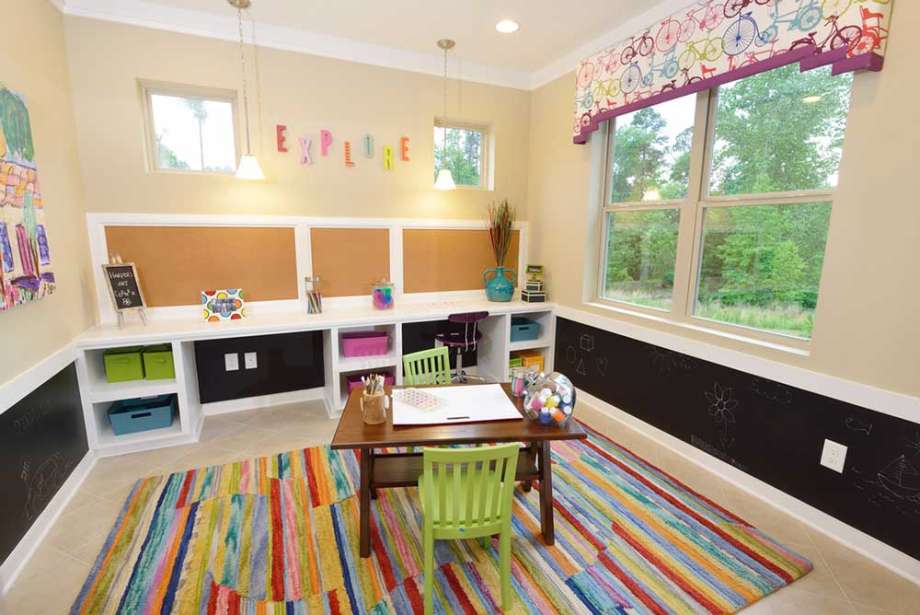How to Create a Learning Space for your Child

Now that your kids are back in school, you may be wondering how to encourage creativity and learning not only in the classroom, but also at home.
An at-home learning space is an incredible way to let your child play and explore the world around them. And while building one may seem like a daunting task, creating a comfortable and inspiring learning space for your children is actually easier than you may think.
There are a few key guidelines to follow in order to best create a learning space that inspires and nurtures your child. Below are a few tips to and inspiration from Pinterest to get you started.
Add lots of natural lighting
If possible, aim to pick a space in your home that has access to lots of natural light.
Many studies have proven that natural lighting in learning environments boosts performance, wellbeing, and creativity. The more natural light, the more conducive the environment is for learning.
If you can’t find a space with natural light indoors, don’t worry. Get creative and build a learning space outside.
More: DIY Kids' Room Renovation Ideas
Be intentional about color
Color can have a profound impact on the human mind. And while every child is different, certain colors can help inspire and motivate us.
In general, younger children thrive in bright, stimulating colors. For example, orange is a warm, inviting color that can help enhance productivity. Green, on the other hand, which is a cool color, can have a calming effect and aid in concentration.
Consider painting the walls or furniture one of these colors to help spark your children’s motivation and curiosity.
Have comfortable, sturdy seating
We all know how painful it can be to sit in an uncomfortable chair for hours on end. It’s no different with your kids.
Make sure the chairs in their learning space are comfortable and provide sufficient back support.
Additionally, include a few seating options – such as chairs, bean bags, and reading nooks – so your child has the freedom to move about as they play and explore.
Provide hands-on activities and self-directed learning experiences
Many child development experts recommend creating a learning space where kids can get their hands dirty – literally and figuratively.
A wide range of hands-on activities – think music, art, reading, writing, puzzles, and games – can help your kids apply their pre-existing knowledge to new experiences.
Encourage your kid to choose their own activities and self direct their learning. Doing so can help them discover what they’re interested in and build confidence, curiosity, and self-reliance.
“The ideal learning space is one where kids can connect their knowledge to experience so that they can construct understandings that are meaningful to them,” Dr. Ashley Gess, an assistant professor of STEAM education at Augusta University, says. “The ideal learning space also supports kids’ transfer of knowledge outside of the original learning context into a new one.”
More: 4 Parents Who Gave Their Kids the Room of Their Dreams
Give options, options, and more options
It’s no secret that kids’ minds grow and evolve at a rapid pace.
In order to keep their growing minds stimulated and engaged, provide plenty of educational options for them and rotate them every few weeks. This way, they won’t get bored and will be excited for their next educational adventure.
Keep things organized
Kids learn best in organized, clean spaces so try to keep clutter at bay.
“[An ideal learning space] provides order that is simple for even the youngest child to grasp, for instance, materials are organized on low shelves so they are accessible to the children at all times, they have a proper place and the pieces are often color-coded to provide a visual cue for order,” notes Breanne Monahan, co-founder and co-owner of Peace Tree School, a Montessori pre-school in Portland, Oregon.
Opt for storage bins or boxes, which can easily be purchased at Target or The Container Store. Then, separate the storage units into categories. For example, dedicate one bin to art supplies and another to books.
An organized learning space makes it easier for kids to decide what they want to play with. Not to mention, it will teach them how to clean up and be organized.
Make it personalized
When a learning space is customized to the specific passions and interests of the child, they will feel as though they have ownership of the space and will be more likely to engage in and care for it.
Encourage them to help you decorate the space. Perhaps this means they can decorate the walls with some of their artwork, paint the desk their favorite color, or hang images of their favorite cartoon characters or subject matters.
Keep room for growth
Lastly, don’t be afraid to keep some spaces empty – don’t feel the need to fill every corner with toys and furniture.
The learning space shouldn’t feel complete or full. Rather, it should feel like a space that can take different shapes and forms over time as your kids grow and find new passions and interests.
For more learning space inspiration, follow our Pinterest board:

